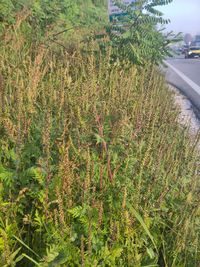Pollen information for Austria from 22 September 2025
After a mostly sunny Monday, a change in the weather will provide relief for allergy sufferers!
While large parts of the country can still expect plenty of sunshine and temperatures of up to 28 °C on Monday, increasingly dense clouds will move in from the west, which could cause precipitation during the course of the day. By the middle of the week, the precipitation will spread across the entire country and temperatures will drop significantly. Pollen allergy sufferers can therefore look forward to a period of relief throughout Austria.
The flight of ragweed pollen and the associated stresses are most affected. While moderate to high pollen concentrations can still be expected in eastern Austria at the beginning of the week, the change in the weather is expected to provide significant relief from Tuesday.
In addition to ragweed, other composite plants, such as the late-flowering mugwort species or Canadian goldenrod, will also cause additional stress. While goldenrod specialises in insect pollination and is therefore only a nuisance in the immediate vicinity of the plants, the pollen of mugwort species can also be transported further afield by the wind.
Exposure to grass pollen rarely reaches concentrations that can cause allergic symptoms. Only in the vicinity of larger reed beds can there still be pollen counts that cause allergic symptoms.
The concentrations of fungal spores in the ambient air remain at a moderate to high level. At higher altitudes, the levels are falling noticeably.
Pollen from stinging nettle, ivy, plantain and cypress plants have also been detected in the ambient air. From an allergological point of view, however, it poses only a minor risk.
Responsible for the content
AZ Pollenresearch GmbH
im Auftrag des Vereins Österreichischer Polleninformationsdienst in Kooperation mit der GeoSphere Austria.
Dr. med. Markus Berger, Dr. rer. nat. Johannes M. Bouchal und Lukas Dirr, MSc.
Wetterdaten und Prognosen basierend auf synoptischen Daten:
GeoSphere Austria, Bundesanstalt für Geologie, Geophysik, Klimatologie und Meteorologie (ehemals ZAMG)
zum Team


